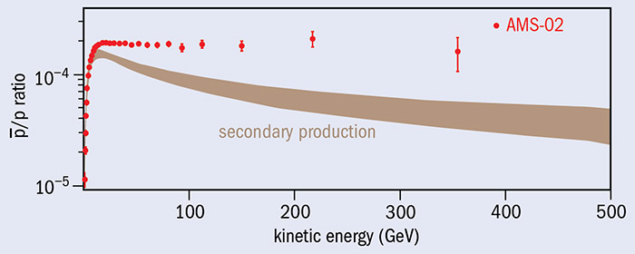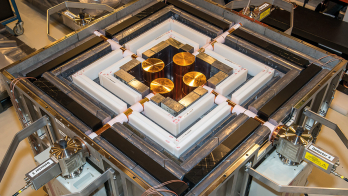Links between research at opposite ends of the distance scale.

Image credit: Planck Collaboration 2015a.
Over the past decade and more, cosmology on one side and particle physics on the other have approached what looks like a critical turning point. The theoretical models that for many years have been the backbone of research carried out in both fields – the Standard Model for particle physics and the Lambda cold dark matter (ΛCDM) model for cosmology – are proving insufficient to describe more recent observations, including those of dark matter and dark energy. Moreover, the most important “experiment” that ever happened, the Big Bang, remains unexplained. Physicists working at both extremes of the scale – the infinitesimally small and the infinitely large – face the same problem: they know that there is much to search for, but their arms seem too short to reach still further distances. So, while researchers in the two fields maintain their specific interests and continue to build on their respective areas of expertise, they are also looking increasingly at each other’s findings to reconstitute the common mosaic.
Studies on the nature of dark matter are the most natural common ground between cosmology and particle physics. Run 2 of the LHC, which has just begun, is expected to shed some light on this area. Indeed, while the main outcome of Run 1 was undoubtedly the widely anticipated discovery of a Higgs boson, Run 2 is opening the door to uncharted territory. In practical and experimental terms, exploring the properties and the behaviour of nature at high energy consists in understanding possible signals that include “missing energy”. In the Standard Model, this energy discrepancy is associated with neutrinos, but in physics beyond the Standard Model, the missing energy could also be the signature of many undiscovered particles, including the weakly interacting massive particles (WIMPs) that are among the leading candidates for dark matter. If WIMPs exist, the LHC’s collisions at 13 TeV may reveal them, and this will be another huge breakthrough. Because supersymmetry has not yet been ruled out, the high-energy collisions might also eventually unveil the supersymmetric partners of the known particles, at least the lighter ones. Missing energy could also account for the escape of a graviton into extra dimensions, or a variety of other possibilities. Thanks to the LHC’s Run 1 and other recent studies, the Standard Model is so well known that future observation of an unknown source of missing energy could be confidently linked to new physics.
Besides the search for dark matter, another area where cosmology and particle physics meet is in neutrino physics. The most recent result that collider experiments have published for the number of standard (light) neutrino types is Nν = 2.984±0.008 (ALEPH et al. 2006). While the search for a fourth right-handed neutrino is continuing with ground-based experiments, satellite experiments have shown that they can also have their say. Indeed, recent results from ESA’s Planck mission yield Neff = 3.04±0.18 for the effective number of relativistic degrees of freedom, and the sum of neutrino masses is constrained to Σmν < 0.17 eV. These values, derived from Planck’s data of temperature and polarization CMB anisotropies in combination with data from baryonic acoustic oscillation experiments, are consistent with standard cosmological and particle-physics predictions in the neutrino sector (Planck Collaboration 2015a). Although these values do not completely rule out a sterile neutrino, especially if thermalized at a different background temperature, its existence is disfavoured by the Planck data (figure 1).
Ground-based experiments have observed the direct oscillation of neutrinos, which proves that these elusive particles have a nonzero mass.
Working out absolute neutrino masses is no easy task. Ground-based experiments have observed the direct oscillation of neutrinos, which proves that these elusive particles have a nonzero mass. However, no measurement of absolute masses has been performed yet, and the strongest upper limit (about one order of magnitude more accurate than direct-detection measurements) on their sum comes from cosmology. Because neutrinos are the most abundant particles with mass in the universe, the influence of their absolute mass on the formation of structure is as big as their role in many physics processes observed at small scales. The picture in the present Standard Model might suggest (perhaps naively) that the mass distribution among the neutrinos could be similar to the mass distribution among the other particles and their families, but only experiments such as KATRIN – the Karslruhe Tritium Neutrino experiment – are expected to shed some light on this topic.

Image credit: AMS.
In recent years, cosmologists and particle physicists have shown a common interest in testing Lorentz and CPT invariances. The topic seems to be particularly relevant for theorists working on string theories, which sometimes involve mechanisms that lead to a spontaneous breaking of these symmetries. To find possible clues, satellite experiments are probing the cosmic microwave background (CMB) to investigate the universe’s birefringence, which would be a clear signature of Lorentz invariance and, therefore, CPT violation. So far, the CMB experiments WMAP, QUAD and BICEP1 have found a value of α – the rotation angle of the photon-polarization plane – consistent with zero. Results from Planck on the full set of observations are expected later this year.
Since its discovery in 2012, the Higgs boson found at the LHC has been in the spotlight for physicists studying both extremes of the scale. Indeed, in addition to its confirmed role in the mass mechanism, recent papers have discussed its possible role in the inflation of the universe. Could a single particle be the Holy Grail for cosmologists and particle physicists alike? It is a fascinating question, and many studies have been published about the particle’s possible role in shaping the early history of the universe, but the theoretical situation is far from clear. On one side, the Higgs boson and the inflaton share some basic features, but on the other side, the Standard Model interactions do not seem sufficient to generate inflation unless there is an anomalously strong coupling between the Higgs boson and gravity. Such strong coupling is a highly debated point among theoreticians. Also in this case, the CMB data could help to rule out or disentangle models. Recent full mission data from Planck clearly disfavour natural inflation compared with models that predict a smaller tensor-to-scalar ratio, such as the Higgs inflationary model (Planck Collaboration 2015b). However, the question remains open, and subject to new information coming from the LHC’s future runs and from new cosmological missions.
AMS now has results based on more than 6 × 1010 cosmic-ray events.
In the meantime, astroparticle physics is positioning itself as the area where both cosmology and particle physics could find answers to the open questions. An event at CERN in April provided a showcase for experiments on cosmic rays and dark matter, in particular the latest results from the Alpha Magnetic Spectrometer (AMS) collaboration on the antiproton-to-proton ratio in cosmic rays and on the proton and helium fluxes. Following earlier measurements by PAMELA – the Payload for Antimatter Matter Exploration and Light nuclei Astrophysics – which took data in 2006–2011, AMS now has results based on more than 6 × 1010 cosmic-ray events (electrons, positrons, protons and antiprotons, as well as nuclei of helium, lithium, boron, carbon, oxygen…) collected during the first four years of AMS-02 on board the International Space Station. With events at energies up to many tera-electron-volts, and with unprecedented accuracy, the AMS data provide systematic information on the deepest nature of cosmic rays. The antiproton-to-proton ratio measured by AMS in the energy range 0–500 GeV shows a clear discrepancy with existing models (figure 2). Anomalies are also visible in the behaviour of the fluxes of electrons, positrons, protons, helium and other nuclei. However, although a large part of the scientific community tends to interpret these observations as a new signature of dark matter, the origin of such unexpected behaviour cannot be easily identified, and discussions are still ongoing within the community.
It may seem that the universe is playing hide-and-seek with cosmologists and particle physicists alike as they probe both ends of the distance scale. However, the two research communities have a new smart move up their sleeves to unveil its secrets – collaboration. Bringing together the two ends of the scales probed by the LHC and by Planck will soon bear its fruits. Watch this space!







